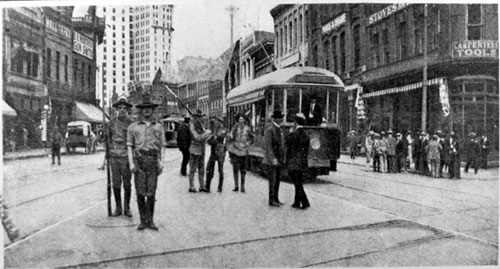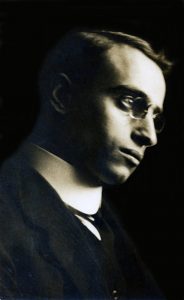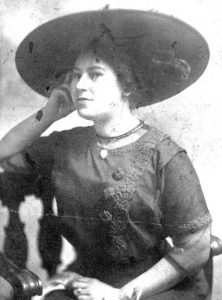The true story of Leo Frank is one that divided a post-Civil War America socially, politically, regionally and racially. It stands as one of the first highly publicized cases of anti-Semitism in the United States.

The Atlanta press falsely report on four different black assaults on white women, drawing State militia guard to an intersection in downtown Atlanta. September 1906. Source: Kenan Research Center at the Atlanta History Center.
After the end of the Civil War in 1865, the state of Georgia was left in economic pieces and public morale was broken. As the 40,000 newly freed blacks started fleeing to growing cities like Atlanta, the fields were left empty of workers, and cotton (the state’s traditional money crop) was neglected. This migration also led to blacks competing with white workers for jobs in booming factories.
In the late 1800s, Jews only made up 1% of Atlanta’s population. However, they owned more than 10 percent of Atlanta’s retail businesses. The Fulton Bag and Cotton Mill, one of the city’s larger employers, was built in 1881 by the Elsas family, who were German Jewish immigrants. With the racial divide between whites and blacks occupying such a prominent place in society, the Jewish community experienced little discrimination for most of the 1800s.
That began to change at the dawn of the 20th century. As blacks acquired more rights, wealth and education, white leaders of Atlanta expanded Jim Crow laws to maintain the racial divide amongst working class whites and blacks. On September 22, 1906, Atlanta newspapers reported four alleged assaults upon local white women, none of which were
ever substantiated. A crowd of whites soon became a mob that disrupted and damaged black communities, leading to reportedly forty deaths of blacks in what is now known as The Atlanta Race Riots. Fears of continued disorder prompted white civic leaders to seek dialogue with black elites to lessen the racial divide.

Pictured: Leo Frank
The dialogue also addressed the poor working conditions and improper treatment of workers in factories such as the National Pencil Factory and the Elsas family’s Fulton Bag Factory. Jews were then blamed for the use of child labor, the low wages and the grueling work hours. Multiple strikes were organized in response. The largest strikes were against the Fulton Bag Factory, though those strikes ultimately failed in 1915.
Leo Frank became a victim of this anti-Semitic hatred in one of the most famous court cases of the early 20th century. A Jew of German ancestry, Frank was raised in Brooklyn and attended Cornell University. He later moved to Atlanta to help supervise the National Pencil Factory, where his uncle was part owner. It was there that he met Lucille Selig, a daughter of a prominent German Jewish family. On November 30, 1910, the two married in an arranged marriage, typical of the times, and enjoyed a high social status amongst the Southern Jewish community.
On April 26, 1913, Mary Phagan, a thirteen-year-old employee of the Pencil Factory, went to receive her paycheck from Frank. Later that night, Mary was found dead in the factory. The shock of the murder resonated throughout Atlanta and all of Georgia. Detectives disregarded two notes found at the scene, identifying the murderer as “a long, tall negro black that hoo it wase,” neglected to test blood found on the basement floor and Mary’s jacket, and instead arrested Frank and charged him with the murder. Anti-Semitism and a resentment of Yankee northerners was clearly a motivating factor in the arrest. In the words of historian John Higham, Frank was “a symbol of the northern capitalist exploiting southern womanhood.”
Leading the trial against Frank was Solicitor Hugh Dorsey. Dorsey obtained testimony from Mary’s friend George Epps, who said that Mary told him Leo Frank had made advances at her. He also obtained testimony from other employees at the factory who claimed they saw Frank flirt with other female workers. An affidavit from Nina Formby, the owner of a local brothel, stated that Frank made calls to her place of work on the day of the murder in an attempt to reserve a room for himself and a girl.
The most important testimony came from Jim Conley, the likely murderer and the “tall negro” mentioned in the notes found on Mary’s body. Conley, however, was coached during long sessions with Dorsey and Conley’s own lawyer to modify his original statement which had been made on May 24th to the police. In the revised affidavit, Conley claimed that Leo Frank asked him to guard the door while he was alone with Mary. However, things went wrong when Mary fell against a machine in the room, dying instantly. Leo Frank then proceeded to ask Conley for help in disposing of the body. The two dragged Mary’s body to the elevator and dumped it in the corner of the basement. It was only afterwards, to disrupt the police’s investigation, that Frank asked Conley to write the two murder notes found on Mary’s body.
The defense called more than one hundred witnesses to attest to either Frank’s good behavior or Conley’s reputation for lying. Defense attorney Reuben Arnold argued that Frank was a victim of rampant anti-Semitism and told jurors that “if Frank hadn’t been a Jew he never would have been prosecuted.” On August 18, 1913, Leo Frank underwent four hours of testimony which included his personal history and account of the night of Mary’s murder. He finished his testimony with the words, “I have told you the truth, the whole truth.” However, the jury found Leo guilty and sentenced him to be hanged.

Pictured: Lucille Selig Frank
Leo’s wife, Lucille, led the fight for an appeal. With new evidence, such as hair found on Leo belonging to another girl that was not Mary, and a rescinded testimony from the brothel owner that Frank had never requested a room the day of the murder, Lucille was able to gain the attention of John M. Slaton, the Governor of Georgia. Governor Slaton, to the dismay of the white Atlanta public, reviewed the case and decided to grant Frank clemency after finding the testimonies given during the trial to be false. Slaton reduced Frank’s sentence to life in prison, hoping to fully absolve him when the public uproar died down.
The Leo Frank case revealed the deep rooted anti-Semitism that festered alongside racism in Atlanta and the country as a whole. It unsettled the Jewish community in Atlanta, who no longer felt as safe as they previously had. The case divided the nation, with The New York Times proclaiming Frank innocent, while southern populist publishers such as Tom Watson called for Frank’s execution. Watson even threatened to give his important endorsement for governor to Hugh Dorsey if Slaton gave Frank clemency, and did so when Slaton commuted Frank’s death sentence. Slaton went on to lose the election, and Dorsey became Georgia’s new governor.
After the trial, 3,000 Jews fled Georgia out of fear, while 33 men founded the Georgia chapter of the KKK, naming it the Knights of Mary Phagan. However, inspired by these events, members of the Atlanta Jewish community created the Anti-Defamation League to fight future anti-Semitism. In 1986, the Georgia State Board of Pardons and Paroles posthumously pardoned Leo Frank, based on new testimony from a man who claimed to have seen Jim Conley take Mary’s body to the basement. Lucille Frank spent the rest of her life in Georgia, where she died in 1957.


1 Comment
The best archive of information about the murder of Mary Phagan can be found at the Online Leo Frank Research Library, which has more than 10,000 documents about the case.